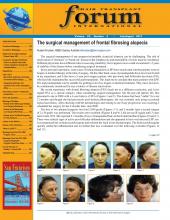The surgical management of any progressive/unstable cicatricial alopecia can be challenging. The risk of reactivation of “dormant” or “burnt out” disease in the lymphocytic and neutrophilic versions must be considered. Different physicians have different rules in assessing suitability, but it appears most would recommend 1-2 years of stability of the disease before considering surgical treatment.
In my personal experience, some cases of lichen planopilaris (LPP) have reactivated, but the patients were no longer on medical therapy at the time of surgery. On the other hand, cases of pseudopelade have never reactivated in my experience, and I also have a 5-year post-surgery patient, who previously had folliculitis decalvans (FD), who has fully maintained his successful graft transplants. This leads me to conclude that many patients with LPP, FD, and pseudopelade can be suitable for grafting even if no longer on medical treatment. They must, however, be continuously monitored for any evidence of disease reactivation.
My recent experience with frontal fibrosing alopecia (FFA) leads me to a different conclusion, and I now regard FFA as a special category when considering surgical management. My 66-year-old patient, JD, first presented to me in 2008 with a 4-year history of FFA (Figures 1 and 2). The disease had been “stable” for over 12 months and though she had previously used hydroxychloroquine, she was currently only using occasional topical tacrolimus. After checking with her dermatologist and waiting to see if any progression was occurring, I scheduled her surgery for her 8 months later, mid-2009.
The first of two planned surgeries involved 2,048 grafts (Figures 3-7), and 5 months later a second surgery of 2,130 grafts was performed. The results were excellent (Figures 8 and 9). I did not see JD again until 3 years later in late 2012. She reported 2-3 months of loss of transplanted hairs at the frontal hairline (Figures 10 and 11). There were clinical signs of active peri-follicular inflammation and she appeared to have oral mucosal LPP, too. I recommenced her on hydroxychloroquine and referred her back to her dermatologist. The hydroxychloroquine quickly settled her inflammation and no further hair loss eventuated over the following 4 months (Figures 12 and 13).
As she was keen to restore her hairline, I agreed to a third surgery that was performed in January 2013. On this occasion 1,526 grafts were implanted. At review by her dermatologist in May (4 months post-surgery), she had no signs of inflammation and her latest grafts were growing in nicely. She is currently using hydroxychloroquine 400mg daily and topical tacrolimus.
Other surgeons have reported loss of grafts in patients with FFA. Dr. Paco Jiminez reported 3 FFA patients with grafted hair loss at the World Hair Congress in Edinburgh in May 2013. Dr. Richard Shiell reports that he has a male patient with FFA who has had repeated surgeries for grafted hair loss over the past 20 years. This raises the question: Does FFA ever really become “stable”?
In view of this case, and other reported cases from colleagues, it is my view that FFA patients should become surgical candidates only if they have no clinical signs of disease, are taking appropriate treatment for the condition, and are prepared to take life-long therapy post-operatively.
- Copyright © 2013 by The International Society of Hair Restoration Surgery



















